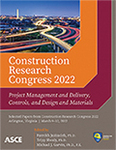Machine Learning Framework to Predict Last Planner System Performance Metrics
Publication: Construction Research Congress 2022
ABSTRACT
Despite numerous attempts toward enhancing performance, the construction industry is still behind in this term. Various technological advancements are at the disposal of construction researchers and practitioners to address this issue. Machine learning techniques are one example of technologies that have become readily accessible to general users thanks to the efforts of researchers in construction planning and control and other fields. Accordingly, the performance in the construction industry may be improved by employing machine learning techniques for developing performance indicators to forecast possible issues or take corrective measures proactively. While some studies have applied machine learning in various aspects of lean construction, no research has yet employed machine learning to predict specific performance metrics. This study, therefore, aims at developing a framework to predict the Last Planner System (LPS) metrics. This will allow optimizing performance on a near real-time basis. A framework for implementing such an approach toward project control is presented, and several predictive models are created, compared, and refined. This approach opens an entirely new avenue for applications of machine learning and data mining techniques in lean construction project planning and control.
Get full access to this article
View all available purchase options and get full access to this chapter.
REFERENCES
Ballard, G. (2000). The Last Planner System of Production Control. PhD Dissertation, Faculty of Engineerimg, The University of Birmingham, UK.
Ballard, G., and Howell, G. (1994). “Implementing lean construction: stabilizing work flow.” Lean construction, 2, 105–114.
Bortolazza, R. C., Costa, D. B., and Formoso, C. T. (2005). “A quantitative analysis of the implementation of the last planner system in Brazil.” Proceedings of the 13th International Group for Lean Construction Conference (IGLC), 413–420.
Dissanayake, M., and Fayek, A. R. (2008). “Soft computing approach to construction performance prediction and diagnosis.” Canadian Journal of Civil Engineering, 35(8), 764–776.
Hamzeh, F., Ballard, G., and Tommelein, I. D. (2012). “Rethinking Lookahead Planning to Optimize Construction Workflow.” Lean Construction Journal, 15–34.
Hamzeh, F., González, V. A., Alarcon, L. F., and Khalife, S. (2021). “Lean Construction 4.0: Exploring the Challenges of Development in the AEC Industry.” Proc. of the 29th Annual Conference of the International Group for Lean Construction 2021, 248–283.
Hamzeh, F., Al Hattab, M., Rizk, L., El Samad, G., and Emdanat, S. (2019a). “Developing new metrics to evaluate the performance of capacity planning towards sustainable construction.” Journal of Cleaner Production 225, 868–882.
Hamzeh, F. R., El Samad, G., and Emdanat, S. (2019b). “Advanced Metrics for Construction Planning.” Journal of Construction Engineering and Management, 145(11), 04019063.
Hevner, A. R., March, S. T., Park, J., and Ram, S. (2004). Design Science in Information Systems Research. MIS Quarterly.
Jiang, Y., Han, S., and Bai, Y. (2020). “Machine Learning-Based Temporary Traffic Control Cost Analysis.” Resilience and Sustainable Transportation Systems, Reston, VA: American Society of Civil Engineers, 86–96.
Lasi, H., Fettke, P., Kemper, H. G., Feld, T., and Hoffmann, M. (2014). “Industry 4.0.” Business and Information Systems Engineering, 6(4), 239–242.
Lucko, G., and Rojas, E. M. (2010). “Research Validation : Challenges and Opportunities in the Construction Domain.” Journal of construction engineering and management, 136(1), 127–135.
Marill, K. A. (2004). “Advanced Statistics: Linear Regression, Part II: Multiple Linear Regression.” Academic Emergency Medicine, John Wiley & Sons, Ltd, 11(1), 94–102.
Mierswa, I., and Klinkenberg, R. (2018). RapidMiner Studio (9.1). Data science, machine learning, predictive analytics, Retrieved from https://rapidminer.com/.
Ming-Te, L., Kuo-Chung, M. A., and Pan, W. T. (2013). “Using data mining technique to perform the performance assessment of lean service.” Neural Computing and Applications, 22(7), 1433–1445.
Moselhi, O., Hegazy, T., and Fazio, P. (1991). “Neural Networks As Tools in Construction.” Journal of Construction Engineering and Management, 117(4), 606–625.
Portas, J., and AbouRizk, S. (1999). “Neural Network Model for Estimating Construction Productivity.” Journal of Construction Engineering and Management, 125(3), 211–212.
Power, W., and Taylor, D. (2019). “Last Planner® System and Percent Plan Complete: An Examination of Trade Contractor Performance.” Lean Construction Journal, 131–146.
Rocha, C. G., Formoso, C. T., and Tzortzopoulos-Fazenda, P. (2012). “Design Science Research in Lean construction: Process and Outcomes.” Proceedings of the 20th Annual Conference of the International Group for Lean Construction.
El Samad, G., Hamzeh, F., and Emdanat, S. (2017). “Last Planner System – the Need for New Metrics.” Proceedings of the 25th Annual Conference of the International Group for Lean Construction, Heraklion, Greece, 637–644.
Tixier, A. J. P., Hallowell, M. R., Rajagopalan, B., and Bowman, D. (2016). “Application of machine learning to construction injury prediction.” Automation in Construction, 69, 102–114.
Zhao, Y., and Chua, D. K. H. (2003). “Relationship Between Productivity and Non Value-Adding Activity.” Proceedings of the 11th Annual Conference of the International Group for Lean Construction (IGLC), Blacksburg, Virginia, USA.
Information & Authors
Information
Published In
History
Published online: Mar 7, 2022
Authors
Metrics & Citations
Metrics
Citations
Download citation
If you have the appropriate software installed, you can download article citation data to the citation manager of your choice. Simply select your manager software from the list below and click Download.
